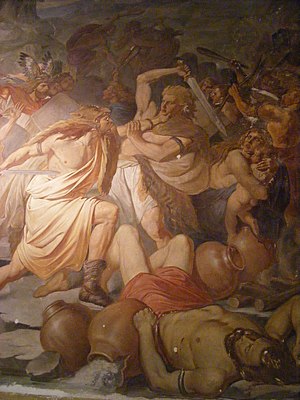Battle between Hermunduren and Chatten 58 AD

Fresco “Battle of the Hermunduren and Katten for the salt springs at Kissingen 58 after Christ” (detail), painted by Georg Hiltensperger jun., 19th century, State Museum for Ethnology, Munich
| date | 58 AD |
|---|---|
| place | Border area (with a salty river) between the tribal areas of the Chatti and the Hermunduren |
| output | Victory of the Hermundures |
| Parties to the conflict | |
|---|---|
According to the historical work Annales of the Roman historian Tacitus, the battle between the Hermundurs and Chatten in 58 AD was the final battle in a border dispute between the Germanic tribes of the Chatten and the Hermunduren . Both parties claimed a river for themselves that had a special religious meaning, but was also well suited for the extraction of salt .
In popular scientific literature, this historical event is sometimes simply referred to as the salt battle .
The battle took place in the summer of AD 58. The exact location of the slaughter site is unknown. With the Hermunduren is obviously meant here the group of Hermunduren, which was neighboring to the Marcomanni and Semnonen ( Longobards ). The group of Hermundurs who settled near the Rhaetian border is out of the question here .
In historical research, several attempts have been made to guess the border river mentioned by Tacitus, but no suggestion fits the report in the Annals of Tacitus sufficiently. The Thuringian Saale , the Franconian Saale, the Werra and the Salzunger salt springs were suggested as the border rivers of the Chatten and Hermunduren .
Remarks
- ↑ Tacitus, Annales 13, 57: "Eadem aestate inter Hermunduros Chattosque certatum magno proelio, dum flumen gignendo sale fecundum et conterminum vi trahunt, super libidinem cuncta armis agendi religione insita, eos maxime locos propinquare. Caelo propiusque mortalium in deis nusquamiri indulgentia numinum illo in amne illisque silvis [s] alem provenire, non ut alias apud gentes eluvie maris arescente, sed unda super ardentem arborum struem fusa ex contrariis inter se elementis, igne atque aquis, concretum. sed bellum hermunduris prosperum, Chattis exitios, quia victores diversam aciem marti ac Mercurio sacravere, quo voto equi viri, cuncta viva occidioni dantur. et minae quidem hostiles in ipsos vertebant. sed civitas Ubiorum socia nobis malo improviso adflicta est. nam ignes terra editi villas arva vicos passim corripitaante f nuper coloniae moenia, neque exstingui poterant, non si imbres caderent, non [si] fluvialibus aquis aut quo ali o humore, donec inopia remedii et ira cladis agrestes quidam eminus saxa iacere, your residentibus flammis propius suggressi ictu fustium aliisque verberibus ut feras absterrebant. postremo tegmina corpori derepta iniciunt, quanto [magis] profana et usu polluta, tanto magis oppressura ignes. "
- ↑ Helfried Spitra and Uwe Kersken: Die Germanen. News, interesting & surprising from the tribes of the north , Bastei Lübbe , Bergisch Gladbach 2009, p. 65 ( limited preview in the Google book search).
- ↑ Hartmut Ruck: Bad Salzungen. Pictures of a city , Sutton Verlag , Erfurt 2001, p. 7 ( limited preview in the Google book search).
- ^ Tacitus, Germania 41.
- Jump up ↑ Wolfgang Jungandreas , Gerhard Mildenberger , Günter Neumann , Harald von Petrikovits : Chatten. In: Reallexikon der Germanischen Altertumskunde (RGA). 2nd Edition. Volume 4, Walter de Gruyter, Berlin / New York 1981, ISBN 3-11-006513-4 , pp. 377–391., Here p. 380. (for a fee at GAO , De Gruyter Online)
literature
- Wolfgang Jungandreas , Gerhard Mildenberger , Günter Neumann , Harald von Petrikovits : Chatting. In: Reallexikon der Germanischen Altertumskunde (RGA). 2nd Edition. Volume 4, Walter de Gruyter, Berlin / New York 1981, ISBN 3-11-006513-4 , pp. 377-391. ( chargeable at GAO , De Gruyter Online)